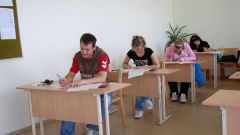You will need
- Textbooks on physics, the textbook algebra and fundamentals of analysis, a textbook on geometry, ballpoint pen, pencil, notebook checks, computer with Internet connection.
Instruction
1
Define for yourself what grade you are applying, passing the exam in physics. This fact affects the difficulty of the exam and, consequently, the duration of the training. As you know, the whole set of tasks in the exam in physics is divided into three main parts, which differ from each other the complexity of the implementation. The first part is a more than twenty test questions, mostly concerning the theoretical information. Some solved this part of the job will allow you to get a satisfactory grade on the exam. The second part of the exam in physics includes tasks brief the type of definite answer, self-explanatory. Thus, the answer to the second part should be, generally some number. If you are applying for a good grade, it will be necessary to solve all tasks from the first part and all the tasks of the second part. Well for an exam you will need to keep more and multiple tasks of the third part, the solution of which is written in expanded form.
2
Go to the website of the Federal Institute of pedagogical measurements. In the menu "use" includes "Demo, specification, codificatory", open it. There you will find demos of the control and measuring materials in recent years. Among them are versions of the works on physics. Download all of these works.
3
Keep a separate notebook to prepare for the exam in physics. Spend all the decisions in this notebook. Try to write down all in detail, and carefully, so you can repeatedly apply to their own decisions.
4
Study the theoretical material on physics and mathematics as necessary. Doesn't make much sense, and most importantly, and time to first learn all the theory and only then proceed to the solution. The decision task of the first part will make you to understand vector algebra and laws of mechanics, to learn the basic fundamentals of electrodynamics, remember the main formula of molecular physics and kinetics. Turning to the second part, you will already savvy in the field of minimal theoretical knowledge.
5
Go to the third part, when you are confident in the ease of solution of the first two parts. For the solution of complex problems, which are usually combined, you need a good mathematical preparation. Such training implies a good knowledge of integral and differential calculus, as well as three-dimensional vector algebra and geometry.
6
Often show their work in preparing for the exam my teacher for physics in high school. Criticism and tips never hurts.






